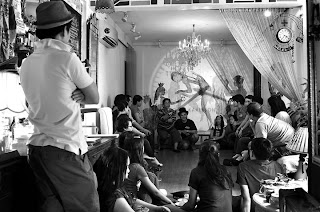I have unsightly scars on my legs. My skin is really sensitive so I scar easily. When I was young, I love riding bikes and I fell off a lot of times when I was still learning how to do it. I would get wounded which would turn into scars. But I didn't care, I would bike anyway. When I was still a student, gym class was always always always an excruciating experience because we were required to wear shorts and my scars would be exposed for everyone to see. Now that I'm older, my wardrobe choices are very limited. I can only wear jeans to hide my scars. I cannot wear shorts, mini skirts, and even capri pants.
I am also not tall. I stand a mere 5 feet. (If you've noticed that this is becoming a litany of my insecurities, please be patient. I have a point, I promise). When I was in high school, I would take vitamins which I heard from somebody would make me taller. (It didn't). I also never wore flat shoes. Only platforms and not lower than two-inch heels for me, thank you very much.
I know those are trivial matters, but it made me miserable for the most part of my adolescence. But at this point in my life I have come to accept my height and the ugly scars in my legs. I couldn't pinpoint the exact moment when it happened, but I have already made my peace with jeans and flat shoes. Yes, I am pandak, and that's okay. I have learned that my physical appearance does not dictate my worth as a person.
This afternoon, I met some people who are trying to come to terms with more serious "imperfections" than height and highly pigmented skin. I attended a get-together of persons who have mental health issues, meaning they or someone they know have been diagnosed with clinical depression or bipolar. It was held at Van Gogh is Bipolar restaurant and organized by the owner, Jetro Rafael and facilitated by Dra. Angie Sunga and Jetro's friend, Robert Alejandro.
Being diagnosed with depression, I understand how lonely it feels to be misunderstood by people who thinks that depression is not a serious mental illness. I've been called many names, among them "brat", "drama queen", and "self-absorbed." That's why it felt good to be in the company of people who did not think that I was any of those names. They understood perfectly how I would sometimes feel the urge to slap people with the Diagnostic Statistical Manual and tell them to educate themselves on depression before they say the words "cheer up", "get over it", "think happy thoughts", etc.
But as much as I may sound as someone who is comfortable with my diagnosis with depression, I've come to realize from the get-together that I have not fully accepted my "imperfection". I push myself too hard to get better, I don't allow myself to cry when the pain gets too much, and I refuse to look at the illness fully in the face. I have even stopped taking medications. In other words, I would still wear high heels even if it hurts like hell. Sure, I would easily admit to myself and to others who would care enough to listen that I have clinical depression. But I lack kindness in the way I treat myself when I mess things up because I'm having an episode. I might need to clarify that what allows me to ignore my condition is because of its nature that it's only a mild one, but chronic, which is called dysthymia. It's a different case with people who have major depression that manifests symptoms they cannot just ignore. They find themselves not getting out of bed, quitting work, and others would even attempt to end their own lives. People with dysthymia, on the other hand, as what Elizabeth Wurtzel described, "are more likely to be the walking wounded. People like me who are quite functional, whose lives proceed almost as usual, except that they are depressed all the time, almost constantly embroiled in thoughts of suicide as they go through their paces. Dysthymia is not just a mild malaise but one that is quite severe and yet still somehow allows an appearance of normalcy because it becomes, over time, a part of life.” I try to pretend that I am normal and as a result of refusing to fully accept my illness, there is always this nagging feeling that I cannot shake off, some sort of an unfinished business, that just won't go away and hounds me all the time. Perhaps in some twisted way I believed that I could get rid of it by ignoring it.
But I know now that I couldn't. It is part of who I am, though not all of me. I have to be comfortable with it in the same way that I am now comfortable with with my height and the scars on my legs. And as Jetro would always say, "celebrate your imperfection". He is one person who is doing this- and well.
I offer prayers and wishes to the people at the get-together that in time, we would all get healed and celebrate life, and believe with all our heart in what Lucy Gomez wrote today in her column in the Philippine Star that "Life is beautiful, always, even if it is sometimes sad."
Photos by Michael Galang of Icebox Imaging
Van Gogh is Bipolar Restaurant is located at 154 Maginhawa St., Teacher's Village, Quezon City
Photos by Michael Galang of Icebox Imaging
Van Gogh is Bipolar Restaurant is located at 154 Maginhawa St., Teacher's Village, Quezon City



